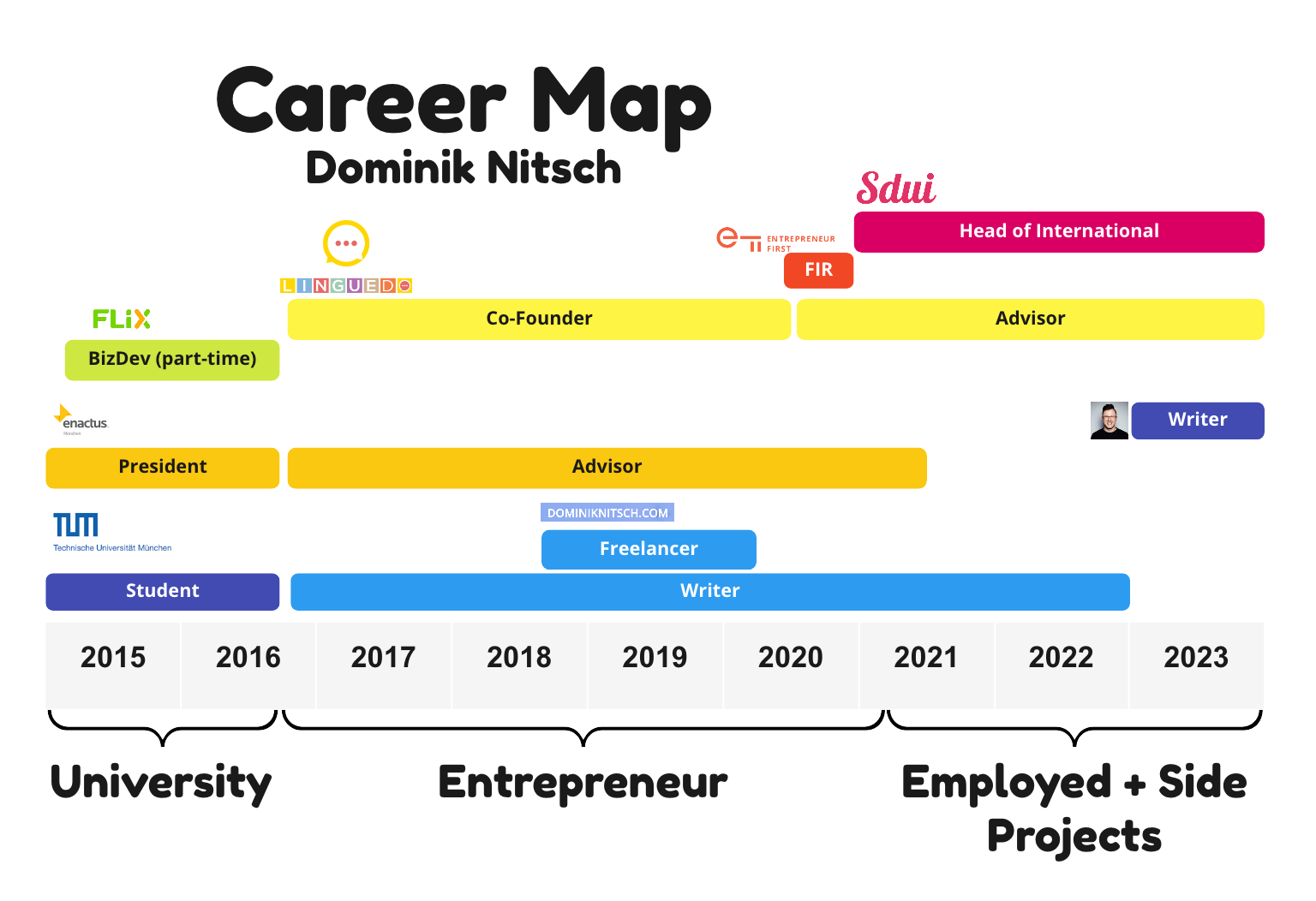International Generalist #6: business secrets from the restaurant industry, using AI for meal planning, and career maps
What makes a business great by learning from restaurants, how to use ChatGPT for meal planning, and mapping out your generalist career on a career map.

Welcome to the 6th issue of International Generalist. Today, we’ll cover business secrets from the restaurant industry, using AI for meal planning, and career maps.
If you don’t find this valuable, you can always unsubscribe at the bottom of this email. If you like it, tell your friends to subscribe here. It’s the best way to support this newsletter. :)
Let’s dive in.
[1] What makes a business great? Lessons from an American restaurant chain
Insights from Bon Appetit (and me).
Every great business is unique. But there are a few things many great businesses get right, regardless of the industry.
When reading this article about the Hillstone Group, a restaurant chain of 48 restaurants across the US, I couldn’t help myself but admire them. The way they’re running their business is brilliant, and it sounds exactly like I would want to run a business.
So I dug in a bit and identified five things Hillstone does well that will help any business succeed:
[1.1] Identifing what the customer wants by actually talking to them
The number 1 thing in every business: talk to your customers. It’s tempting to build products sitting in your ivory tower, but unless you interact with the humans that you’re solving a problem for, you won’t know whether what you’re doing is actually working.
Hillstone does this well: they understand what a customer wants - great service, great food, with consistency. Whether that is sushi, a burger, draft beers or fancy wine, that is up to the customer. Hillstone has it all.
Even their menu is inspired by customer feedback:
“Fun fact for Hillstonians: The [Spinach-Artichoke] dip was “created” by regulars at Houston’s in Chicago. Customers started ordering the spinach and artichoke side with chips. Salsa and sour cream were added later, giving the combo the name “Chicago-Style Spinach and Artichoke Dip.””
Michelin-Chef Michael White also acknowledges this in the article:
“We chefs take ourselves a bit too seriously. Where Hillstone succeeds is pinpointing what people want and giving it to them.”
[1.2] Going through the customer journey thousands of times, allowing yourself to anticipate needs before the customer knows he has them
“And then something happened that really got Christina’s attention. Before she had time to respond, she was holding a glass of Champagne and I was sipping my 50/50 gin martini. If this had been any other place in New York, we’d still be trying to get the bartender’s attention. In less than three minutes, we had confirmed our reservation with the smiling hosts, checked our coats, snagged some space at the bar, and ordered drinks.”
This is a wonderful user experience. You know that feeling when everything works a little bit better than expected? That’s what happens if you know the ins and outs of your customer journey.
Hillstone knows that:
- People hate attempting to get the bartender’s attention
- People dislike waiting for the menu to order, or for their drinks to arrive
- People want to know right away that their reservation exists
How do they know that? By being regulars at other restaurants, where they go through the customer journey over and over again.
You can use the same cue for your business: try going through your customer journey to iron out even the smallest issues - until the product or service is perfect.
[1.3] Not cutting corners
“That’s the brilliance of Hillstone,” Coraine said. “They don’t cut corners.”
When you go through the customer journey, you will realise that some things aren’t that easy to fix. Do them anyway. Hillstone has a beautiful example of this:
“the fact that you’ll never have to fix a wobbly table because they’re all drilled into the floor, thereby eliminating the single biggest annoyance in the history of dining”
Whoa. That is attention to detail.
And I’m certain they don’t cut corners with the quality of their food either. Will it be more expensive? Yes. Will people be willing to pay more for it? Also yes.
I had a similar experience at Linguedo, my first start-up. We brought nurses from Italy to Germany, and unlike all the other agencies on the market, we actually did the language training of the nurses ourselves. That allowed us to drill German into them at a much higher level than the agencies who outsourced the learning part.
Was it more expensive? Yes.
Were our clients willing to pay more for it? Also yes - a LOT more.
[1.4] Being consistent every single time
“Every Hillstone, I had learned, is mind-bogglingly consistent.”
“It’s their ability to put out the same great product no matter what the location, again and again, that amazes me,” Shook said.”
We experience delight when your expectations are met or exceeded. When your product or service is consistent in doing, customers will experience delight.
This is really difficult to do, but it will keep your customers coming back.
Think about it:
- Why do you always go to the same hairdresser?
- Why do you have your go-to neighborhood joint where you eat at least once a week?
- Why are you a regular at a bar?
Because you know what you’re getting.
Every single time.
[1.5] Building an environment that allows the team to work best
No business can work without a great team.
First, you need to hire well.
Second, you need to provide the environment that allows people to thrive.
“He already knew that if you were a server at a Hillstone, you would never be saddled with more than three tables. That’s why at every Hillstone restaurant, the total number of tables is divisible by three. There are no food runners or bussers. It’s a team effort, which means your server will take your order, but anyone on staff can help you out. “
This is exactly the kind of environment that allows people to work at their best: providing the freedom and capacity for employees to do what they’re really good at.
Simon Sinek has a fantastic video about building the right environment for employees, where:
- You feel safe about your job
- You feel trusted to do the job you’ve been trained to do
Creating the environment is the responsibility of the leader. According to Sinek:
- “Leadership isn’t about being in charge, it’s about taking care of the people in your charge.”
- “Leaders aren’t responsible for the results, they’re responsible for the people who are responsible for the results.”
It’s not the people. It’s the environment. And it’s the leaders that create the environment.
Which Hillstone seems to have gotten down perfectly.
[2] GPT-4 is here. Absolute game changer - and my new personal chef.
OpenAI released GPT-4 for ChatGPT Plus subscribers this week. It’s much, much more competent than the AI that we saw initially with ChatGPT. Here’s an intriguing Twitter thread about its capabilities.
There’s one use case for which I’ve been using ChatGPT for a while: meal planning. The output is really good, and I don’t really have to think about anymore what I want to eat. It even writes my shopping list, so my effort for grocery shopping is basically zero.
Which is great: another way to eliminate decisions. When I get home, I don’t have to think about what I want to eat. It’s already on the plan.
Here’s the prompt I use for meal planning. Feel free to play around with it:
You are a personal chef. Please generate a meal plan for week 12. The plan should include 3 meals, with recipes coming from the Italian, Mexican and Thai cuisine. The recipes should contain meat, be low-carb and rich in vegetables. Please provide recipes in European measurements and adjust for four servings. After generating the recipes, please consolidate the recipes into one shopping list.
(If you’re interested, here’s the output.)
Like it or not: AI is here to stay.
So start using it in your everyday life, and learn how to use it properly.
Being able to Google well was yesterday.
Being able to use AI properly is today. And likely the future.
[3] Messy CV? Try a Career Map.
Insight from Elena Verna.
CVs are wonderfully linear. But they don’t really apply to people who work multi-dimensionally. Now more than ever, people are diversifying revenue streams and jobs, part-time is common, and many have a side gig.
How do you show this in a CV? It’s difficult. A CV assumes that you only do one thing at a time. If you do more, it gets really messy. For example, take a look at the typical VC Partner’s LinkedIn profile: Board Member here, Board Observer there … you have zero clue what they actually do.
Enter the career map: a map that visualises different streams you’re working on, and depicts much better the chaotic twists and turns a career can take.
Here’s mine (FIR = Founder-in-Residence):

Elena Verna wrote a great post about this concept (which is also where I took the template from). Read it here:
—
Action item recap:
Learn from Hillstone and steal their best practices for your business.
Figure out what your customer needs
Deeply understand the customer journey
Don’t cut corners
Be consistent
Build an environment that empowers people to work at their best
Start using AI now. Maybe for meal planning. Maybe for a lot of other things, too.
Build out your own career map - and use it instead of a CV next time you’re applying somewhere.
—
That’s it for this edition of International Generalist. Thanks for tuning in and reading!
If you enjoyed this, please ask yourself: which one person that you know would most benefit from reading this newsletter? The number one way to support me is to share this with others aspiring to become more effective in their personal and professional lives.
Who’s behind International Generalist?
I’m Dominik, and every day, I try to figure out how to become a tiny bit more effective. Then, I share some of the lessons learned here.
When I’m not writing, I build the international business for Sdui - the Leading European SchoolOS -, play Lacrosse and enjoy draft beers.
Here’s how else I can help you:
- Book a 1:1 meeting to discuss the international expansion strategy of your startup
- Read the newsletter archive for more actionable nuggets
- Connect on LinkedIn or Twitter for daily doses of insights
- Send me a question, so I can answer it in the newsletter or in a long-form blog post
See you in two weeks!
Much love
Dominik
Dominik Nitsch Newsletter
Join the newsletter to receive the latest updates in your inbox.



